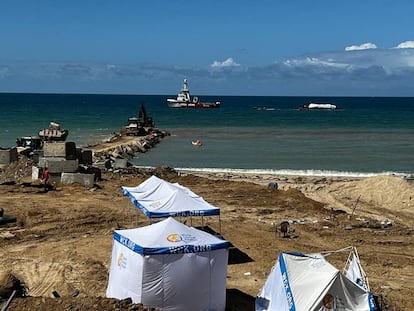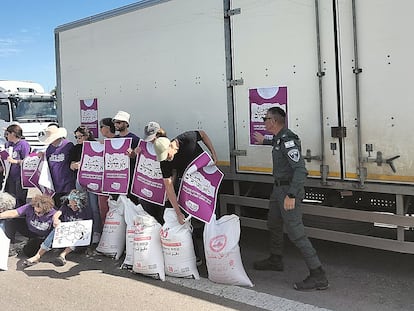The ‘Open Arms’ arrives in Gaza to carry out the first delivery of humanitarian aid by sea
The EU has warned that shipments by air and by ship “are not enough” and that Israel must open other land crossings that are currently closed

The Safeena mission, the first to bring humanitarian aid to Gaza by sea, arrived on the coast of the Strip this Friday afternoon and began unloading 200 tons of food transported from Cyprus by the ship Open Arms, operated by a Spanish non-profit that normally conducts rescues in the Mediterranean Sea. “Everything is going very well, we are very happy. This was a pilot test and it worked,” said Gerard Canals, operations coordinator.
The mission, promoted jointly by this humanitarian organization and by World Central Kitchen (WCK), a food aid group founded by Spanish-American chef José Andrés, is of tremendous “complexity,” as both groups have repeatedly warned in recent days. The difficulty, beyond diplomatic and meteorological obstacles, lies in the way the cargo is being delivered, given that Israel does not allow the occupants of the tugboat to establish contact with the Gaza population.
A second ship is being stowed in the port of Larnaca with 400 more tons of food aid, in a new operation also promoted by WCK and the governments of Jordan, Cyprus and the United Arab Emirates.
The Open Arms arrived south of the capital on Thursday night, 72 hours after departing from the port of Larnaca in Cyprus, thus reopening an access route that had been closed since 2007, when the Islamist movement Hamas took power in Gaza and Israel imposed a land, sea and air blockade that tightened after the October 7 attack.
This Friday morning the ship anchored approximately a mile away from the beaches of Gaza City, in the north of the enclave. The barge transporting the aid, a total of 130 pallets of non-perishable food, was towed by two semi-rigid boats from the Open Arms to a jetty built by WCK workers in the Strip. At 3:10 p.m. local time, the barge was moored to the jetty, which was erected in record time with the rubble of the buildings destroyed by the Israeli bombings.
The pallets were transferred from the barge to the jetty with a crane truck placed at the edge of the dock. From there, the aid started going into trucks that will distribute it to the 60 kitchens that WCK operates in different parts of Gaza, and to other food distribution points. In total, there are 200 tons of flour, rice, lentils, chickpeas, canned tuna and other basic foods that will become a million meals, according to chef José Andrés.
The unloading work took place without incident and “quite quickly,” according to the crew members. However, the waves and nightfall slowed operations slightly in the last few hours. At 9.30 pm, a quarter of the merchandise still remained to be unloaded. The Open Arms is scheduled to return to Cyprus afterwards, concluding the pilot test of the operation. “We had a plan of how everything should go; before departing, the authorities had given us detailed instructions about what to do, and everything was carried out almost on time,” Canals described in a telephone conversation.
With a bottleneck for taking aid by land and the limitations of parachute shipping, the opening of this maritime humanitarian corridor will not generate a substantial change in the situation in the Strip, where more than half a million people are “on the brink of famine,” according to the United Nations. The 200 tons of aid that has been brought to the beaches of Gaza are equivalent to the load of 12 trucks. The usual flow before the war was about 500 trucks a day.
White House concerns
One of Washington’s main concerns is humanitarian aid. A Israeli military spokesman recently said that his country (which has been using hunger as a weapon of war) will now “flood” Gaza with humanitarian aid. This week, the military began a pilot project allowing six United Nations trucks to enter directly into the north, where the situation is most dire. There are seven crossings with Gaza: Rafah, which borders Egypt, and another six with Israel. Only the first and one of the Israeli ones have been partially open since the beginning of the conflict.
With half a million people on the brink of famine and the first deaths (especially children) due to malnutrition or dehydration, the European Commissioner for Crisis Management, Janez Lenarcic, warned on Thursday that humanitarian aid shipments by air and by sea “are not enough.” Israel, he added, must open other land crossings with Gaza that it currently keeps closed. The amount of food or medicine that can be delivered by road is much greater than what can be dropped by parachute or delivered by sea. It is also cheaper and faster and less complicated from the point of view of logistics.
Sign up for our weekly newsletter to get more English-language news coverage from EL PAÍS USA Edition
Tu suscripción se está usando en otro dispositivo
¿Quieres añadir otro usuario a tu suscripción?
Si continúas leyendo en este dispositivo, no se podrá leer en el otro.
FlechaTu suscripción se está usando en otro dispositivo y solo puedes acceder a EL PAÍS desde un dispositivo a la vez.
Si quieres compartir tu cuenta, cambia tu suscripción a la modalidad Premium, así podrás añadir otro usuario. Cada uno accederá con su propia cuenta de email, lo que os permitirá personalizar vuestra experiencia en EL PAÍS.
¿Tienes una suscripción de empresa? Accede aquí para contratar más cuentas.
En el caso de no saber quién está usando tu cuenta, te recomendamos cambiar tu contraseña aquí.
Si decides continuar compartiendo tu cuenta, este mensaje se mostrará en tu dispositivo y en el de la otra persona que está usando tu cuenta de forma indefinida, afectando a tu experiencia de lectura. Puedes consultar aquí los términos y condiciones de la suscripción digital.
More information
Archived In
Últimas noticias
Welcome to the post-religion era: The idea of Christianity as the absolute truth has become obsolete
‘I thought you would like it’: The risky sexual practice popularized by TV shows and TikTok
The digitalization of tourism: ‘They promise experiences and gave us the worst possible one’
Mexican peso defies uncertainty with forecasts of a new period of stability in 2026
Most viewed
- Sinaloa Cartel war is taking its toll on Los Chapitos
- Oona Chaplin: ‘I told James Cameron that I was living in a treehouse and starting a permaculture project with a friend’
- Reinhard Genzel, Nobel laureate in physics: ‘One-minute videos will never give you the truth’
- Why the price of coffee has skyrocketed: from Brazilian plantations to specialty coffee houses
- Silver prices are going crazy: This is what’s fueling the rally










































